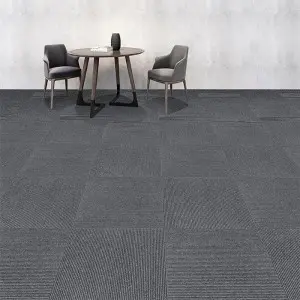When selecting flooring materials for commercial or residential spaces, one common question arises: which is better—wool or nylon carpet?
Both materials dominate the global carpet market, but they differ in composition, durability, comfort, and long-term cost efficiency. For B2B buyers such as distributors, interior contractors, and developers, understanding these distinctions is key to choosing the right carpet for each project.
Wool Carpet: Natural Luxury and Long-Term Value
Wool carpets are made from natural fibers sheared from sheep, offering exceptional softness and resilience. They are valued for their natural warmth, sound insulation, and luxurious appearance—making them a top choice for high-end interiors.
Main advantages of wool carpets include:
Soft and comfortable underfoot, with excellent acoustic and thermal insulation.
Naturally resilient fibers that recover from crushing and retain shape for years.
Resistant to stains and moisture due to the natural lanolin coating on wool fibers.
100% biodegradable and renewable, ideal for eco-conscious projects.
Elegant and timeless appearance suitable for hotels, villas, and executive offices.
Nylon Carpet: Durability and Cost Efficiency
Nylon carpets are made from synthetic fibers known for their toughness and versatility. They are widely used in high-traffic commercial environments due to their consistent quality, durability, and lower upfront cost.
Main advantages of nylon carpets include:
Excellent strength and resilience under heavy foot traffic.
Bright, colorfast appearance thanks to advanced dyeing technology.
Easy to clean and maintain, saving time and labor costs.
Lower initial investment while maintaining professional aesthetics.
Good moisture and stain resistance for offices, schools, and retail spaces.
For businesses seeking practical and durable flooring solutions, nylon carpets offer strong value and long-term dependability.
Comparing Wool and Nylon Carpets
While both materials perform well, their advantages serve different market needs:
Comfort and style: Wool carpets provide superior softness and luxury appeal.
Traffic resistance: Nylon carpets perform better in busy commercial areas.
Maintenance: Wool needs gentle care; nylon is more stain-resistant and easier to clean.
Sustainability: Wool is natural and biodegradable; nylon is synthetic but partially recyclable.
Longevity: Wool carpets can last 20–25 years with care, while nylon lasts around 10–15 years.
The decision depends on your project type, target market, and long-term priorities.
B2B Perspective: Choosing the Right Material for Business Success
For luxury-focused projects, such as hotels, showrooms, and executive offices, wool carpets deliver unmatched comfort and natural aesthetics that elevate brand image.
For large-scale commercial or cost-sensitive projects, such as corporate offices, educational institutions, or retail spaces, nylon carpets offer reliability, durability, and ease of maintenance.
For distributors and importers, providing both options—wool and nylon—can expand your customer base and strengthen your market competitiveness.
The B2B Advantage: How the Right Carpet Choice Boosts Business Value
In the B2B market, carpet selection goes beyond design—it directly impacts client satisfaction, maintenance budgets, and long-term ROI.
Key business advantages of choosing the right carpet material:
Higher customer retention: Offering the right balance of quality and price helps maintain long-term client relationships.
Improved cost control: Choosing materials based on application reduces replacement frequency and maintenance costs.
Brand differentiation: Supplying sustainable wool or high-performance nylon carpets enhances your professional reputation.
Global sourcing flexibility: Reliable suppliers ensure consistent production and smooth logistics for bulk export.
A strategic product mix that includes both wool and nylon options allows your business to adapt to different project demands and expand into new markets.
Conclusion
When comparing wool or nylon carpet, the best option depends on your project goals and market positioning. Wool offers unmatched luxury, comfort, and sustainability, while nylon provides superior durability and cost performance.
For B2B buyers, the key to success lies in understanding customer needs, offering diverse material options, and maintaining reliable supply chains to support large-scale projects with confidence.
FAQ
1. Which carpet lasts longer?
Wool carpets can last up to 25 years with proper care, while nylon carpets typically last 10–15 years under heavy traffic.
2. Is wool carpet more expensive than nylon?
Yes. Wool is a natural premium fiber, so its initial cost is higher, but it offers greater long-term value and visual appeal.
3. Are nylon carpets environmentally friendly?
Nylon carpets are partially recyclable and energy-efficient to produce, though wool remains the more sustainable choice overall.
4. Can both types of carpets be customized for B2B projects?
Absolutely. Both wool and nylon carpets can be customized in terms of pattern, color, pile height, and backing to suit project-specific requirements.
Post time: Nov-12-2025












